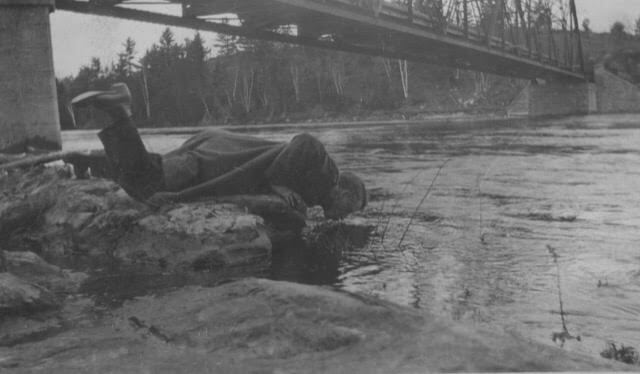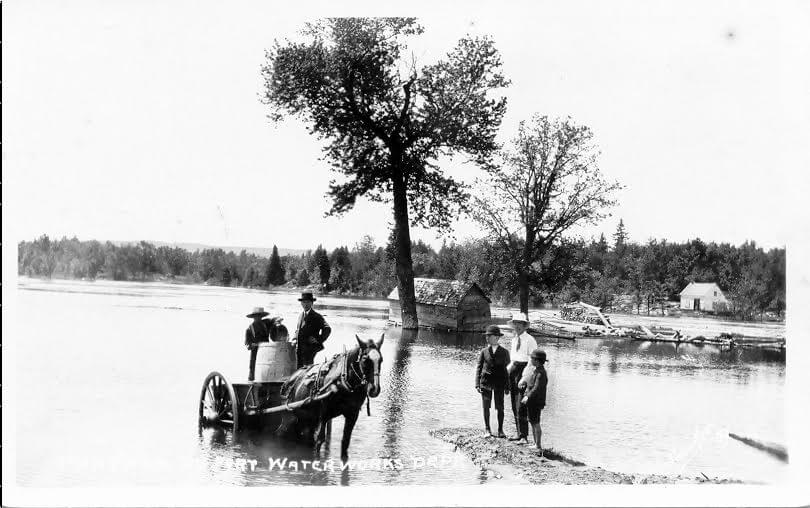Posted: October 27, 2018
A Look at Drinking Water Challenges in Portage-du-Fort

Portage-du-Fort has had an interesting history with drinking water, especially since the installation of a brand new treatment plant for the population of only 250 people.
By Riverwatcher Bob Simpson, resident of Portage du Fort and former Municipal Councillor
History
The town of Portage Du Fort is located along the Ottawa River about 100 kilometers upstream from the City of Ottawa. Established over 200 ago, early residents got their drinking water directly from the Ottawa River or from rain barrels. There was also a home delivery service with a contractor bringing water around to residents by horse drawn wagon.
Photos courtesy of Albert Wright and Pontiac Archives.
The construction of the Chenaux Generating Station and dam in the early 1950’s raised water levels behind the dam creating a reservoir. This enabled water to be drawn from the Ottawa River to supply a potable water treatment plant.
Portage Du Fort’s first drinking water treatment plant was built, along with associated distribution pipes, in the early 1950’s. It was a fairly primitive plant by modern standards, simply taking water from the river above the dam, adding chlorine, and then sending the water through the distribution system to the town’s residents. Although the water was tea-coloured due to tannins in the water, it was safe to drink.
The Walkerton E. coli outbreak in May of 2000 led various governments to review drinking water treatment operations with a view to reducing risks of similar incidents while assuring drinking water quality. It was originally hoped to supply the town’s drinking water needs with groundwater drawn from wells, as this would eliminate the need for water filtration in addition to chlorination and would keep capital and future operating costs down. However, after seven exploratory wells were drilled at a cost to the town of about $270,000, it was found that there was not enough water available from this source to meet the town’s needs.
It was then decided that a new treatment plant would be needed to be replaced the existing system.
The new plant
A new water treatment plant, with a state-of-the-art three stage filtering system, was built and opened in 2014. The cost of building the plant was over $3,500,000 and the cost of operating the plant is well over $100,000 annually. The municipality of Portage Du Fort, with its taxpayer base of about 250 people, paid a significant portion of the capital costs and is responsible for the operating costs of the new plant.
The new water treatment plant immediately encountered a series of problems:
- Although it produced excellent water, that water travelled through 70 year old pipes with several leaks to reach the residents’ homes and businesses. This introduced contaminants into the clean water, and with a cost of nearly $1,000,000 to replace the pipes the town was in no position to absorb this cost.
- Although based on Government of Québec consumption standards for rural municipalities, plus a reasonable growth projection, supply problems were encountered almost immediately. In the first winter this was partly due to many homeowners’ habit of running water continuously to prevent their pipes from freezing. The plant could produce 120 cu. m. of water per day but consumption at cutover was nearly 200 cu.m. per day. This placed excessive demand on the plant resulting in shutdowns. Fortunately the old plant was still available, so the town spent months flipping back and forth between the two plants. Each time the town switched back and forth the pipes had to be flushed which was a difficult task, especially during the winter. Even when the town was on the old plant the water quality still passed government requirements, but was certainly not as clear as the water provided by the new system. Later in the spring consumption limits, including restrictions on washing cars and watering lawns, were imposed.
- The new plant had various technical and operating problems as well, including major computer issues, that resulted in many service calls to the company that was responsible for its installation. This resulted in the plant being shut down almost as much as it was operating. As the tax rates continued to climb due to the costs associated with the plant homeowners tempers were at an all time high with various media outlets becoming involved with the story.
Current Situation
The town operates without water meters and taxpayers pay a flat rate for their water, but threats from the government of installing meters at homeowners expense has convinced people that it was time to take water conservation seriously. As a result, average daily consumption is down to between 75 and 90 cu. m. per day which is well within the new plant’s limits. Repairs have been done to reduce the volume of water leaking out of the pipes which has helped reduce the amount of water required. Additionally, grants have been obtained from the government to replace several hundred meters of the main line pipes, which should help prevent leaks that have plagued the system for years.
It’s been a tough 4 years working with this situation and it will remain an ongoing struggle to obtain funds to replace the remaining distribution pipes. The taxes in Portage are now extremely high, seeing as the plant won’t be paid off until 2033.
Meanwhile, our new water tech tells us that the Portage issue is now so well known that it was taught as part of her training course for obtaining her water technician diploma.
< Previous post Next post >

